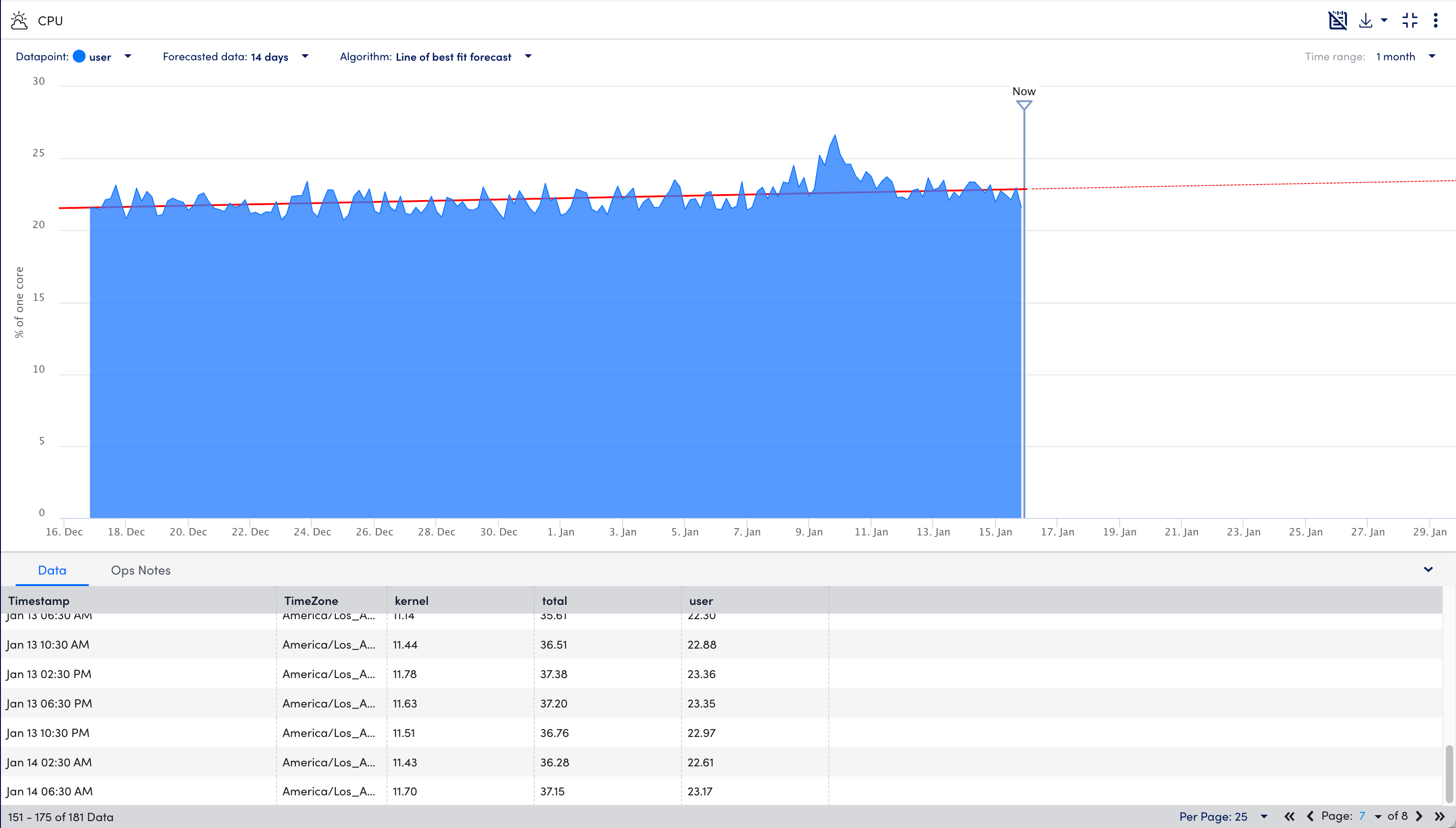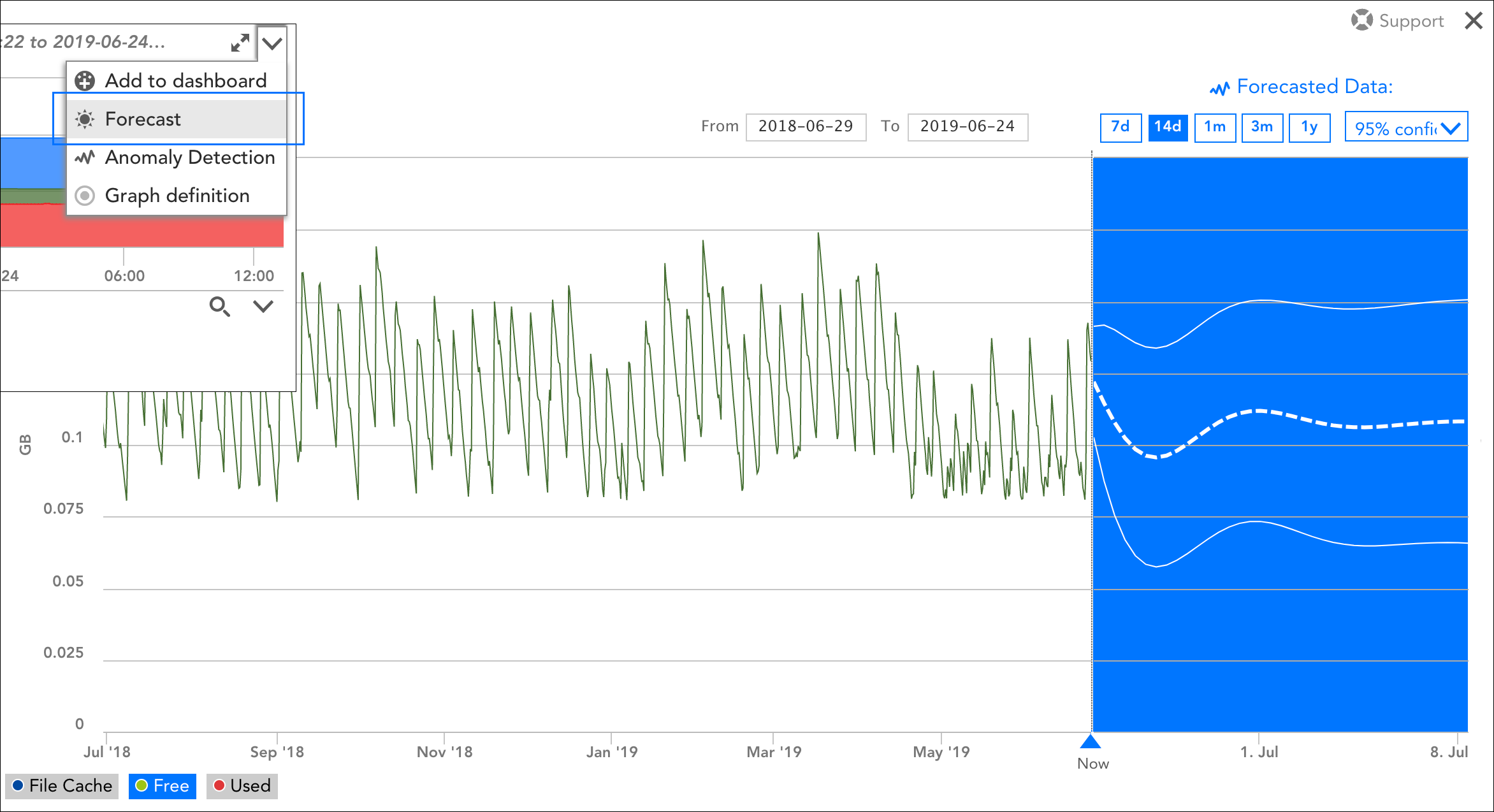The data forecasting feature enables you to predict future trends for your monitored infrastructure by analyzing past performance. It identifies and removes anomalies or missing data from your sample set and then applies a capacity trending algorithm to project future trends.
The data forecast graph visually distinguishes between historical data and projected forecasts by using different background colors. These colors help you to identify whether you are viewing historical data or projected insights. In addition, a vertical date line, labeled “Now,” is displayed on the graph, serving as a clear demarcation between previously collected data and forecasted values.
Note: LogicMonitor does not support alerts based on forecasted data, it can predict when a datapoint exceeds its alert threshold. Specifically, both the Table widget and the Alert Forecast report provide insights into when selected datapoints will trigger alerts. For more information, see Table Widget and Alert Forecast Report.
The following are the benefits of using Data Forecast:
- AIOps-Driven issue diagnosis and mitigation—Helps identify and address potential issues before they escalate
- Alert evaluation—Assists in determining whether an alert is a one-time anomaly, requires immediate action, or will need future attention
- Budget planning and resource forecasting—Provides visibility into the lifecycle and capacity of infrastructure components (For example, SSDs and disks) for better budget allocation
- Optimizes operational and financial planning—Enhances decision-making by forecasting the timeframe and scale of recurring events, enabling more accurate financial and operational strategies
Requirements for Viewing Data Forecast Graphs
To view the data forecasts, you need the following:
- A user with the “Manage” permissions set at the Resource group level
- A user with LogicMonitor Enterprise license
Viewing Data Forecast Graphs
- In LogicMonitor, navigate to Resource Tree> select a required resource> Graphs tab.
Alternatively, you can access the Data Forecast graph from Alerts, Dashboards, or Services. - Select
and then View Forecast on the top-right corner of the graph.
The data forecast page displays the previously collected data and the forecasted data.
- From the Datapoint dropdown menu, select the required datapoint for which you want to view the data forecast.
Note:
- Forecast graphs can only visualize one datapoint or instance at a time.
- If you access the data forecast from the Alerts page, use the legend selections at the bottom left corner of the window to toggle between datapoints.
- From the Forecasted data dropdown menu, select the duration of the forecast.
- From the Algorithm menu, select one of the following:
- Line of best fit forecast (default)—This method draws a single straight line that best fits forecasted data. This is generally a more useful option if your datapoints are highly variable.
- 95% confidence forecast—This method projects lines that represent forecast values (the middle, thick dashed line), as well as upper and lower confidence bounds. These confidence bounds indicate that LogicMonitor is 95% confident that future datapoint values will fall within this range.
- From the Time range dropdown menu, select a time range for the collected data (training data) that will be used as the basis for the forecast.
- You can view the data (timestamp, timezone) and associated Ops Notes in the details panel at the bottom and do the following:
- Select
Show Ops Notes to show the associated Ops Notes.
- Select
Download and choose in which format either CSV or PDF you want to download the forecast graph data.
- Select
Exit fullscreen to stop the view in fullscreen mode.
- Select
to view the more options.
- Select
Overview
LogicMonitor’s data forecasting allows you to predict future trends for your monitored infrastructure, using past performance as the basis. When forecasting data, LogicMonitor first identifies and removes anomalies and missing data from the sample (i.e. the set of data you choose for forecasting). Then it applies a capacity trending algorithm to the sample to find a model of best fit for the collected data and calculate future data based on these model parameters.
Forecasting is an AIOps tool that is very helpful for issue diagnosis and mitigation. When paired with LogicMonitor’s alerting system, forecasting can help you determine whether an alert represents a one-time anomaly, requires immediate attention, or will require attention in the near future. For example, imagine for a moment that you have received a warning alert indicating that disk usage is at 85%. A key question that arises is how much time until the disk hits a critical threshold of 95% usage? One or two days? Or is there still plenty of time before disk usage creeps to 95%? In this case, forecasting would analyze the past rate of rise in order to predict the future rate.
Forecasting is also helpful for budget planning and resource management. For infrastructure components that have lifetimes (e.g. solid state drives) or capacity (e.g. disk) associated with them, forecasting based on the predicted health and performance of your monitored devices can provide insight into the timeframe and magnitude of recurring events, as well as upcoming expenses.
Forecast Graphs
Similar to anomaly visualization, data forecasting is available from any graph in the LogicMonitor interface, regardless of whether it is being viewed from the Graphs tab, Alerts page/tab, or dashboard.
To display the forecast version of a graph, click the dropdown arrow in the upper right corner of the graph and select “Forecast” from the dropdown menu. A dedicated forecast graph opens. As shown next, the forecast graph uses background color to differentiate between previously-collected data and forecasted data.
Note: Forecast graphs can only visualize one datapoint or instance at a time. If your graph includes data for multiple datapoints (or multiple instances per datapoint), use the legend selections in the bottom left corner of the graph window to toggle between datapoints/instances.
As discussed in the following sections, there are several unique tools available for forecast graphs that you can use to derive additional context from the data presented.
Time Range for Collected Data
In the upper left corner of the forecast graph, select a time range for the collected data (i.e. training data) that will be used as the basis for the forecast. You can specify a custom time range using From and To fields or you can use the preset options of one month, three months, six months, and one year. Data with timestamps during the specified time range will be used to calculate the forecasted data.
Time Range for Forecasted Data
In the upper right corner of the forecast graph, select the duration of the forecast. You can choose to forecast out seven days, 14 days, one month, three months, or one year from now.
Forecast Method
From the dropdown available in the Forecasted Data area, choose which forecast method you would like to use to calculate and display the forecast:
- 95% confidence forecast. This method projects lines that represent forecast values (the middle, thick dashed line), as well as upper and lower confidence bounds. These confidence bounds indicate that LogicMonitor is 95% confident that future datapoint values will fall within this range.
- Line of best fit forecast. This method draws a single straight line that best fits forecasted data. This is generally a more useful option if your datapoints are highly variable.
Alert Forecasting
Although LogicMonitor doesn’t currently offer the ability to alert on forecasted data, it does have the ability to predict when a datapoint is likely to surpass its designated alert threshold. Specifically, both the Table widget and the Alert Forecast report offer insight into when specified datapoints will go into alert. For more information on these, see Table Widget and Alert Forecast Report respectively.


